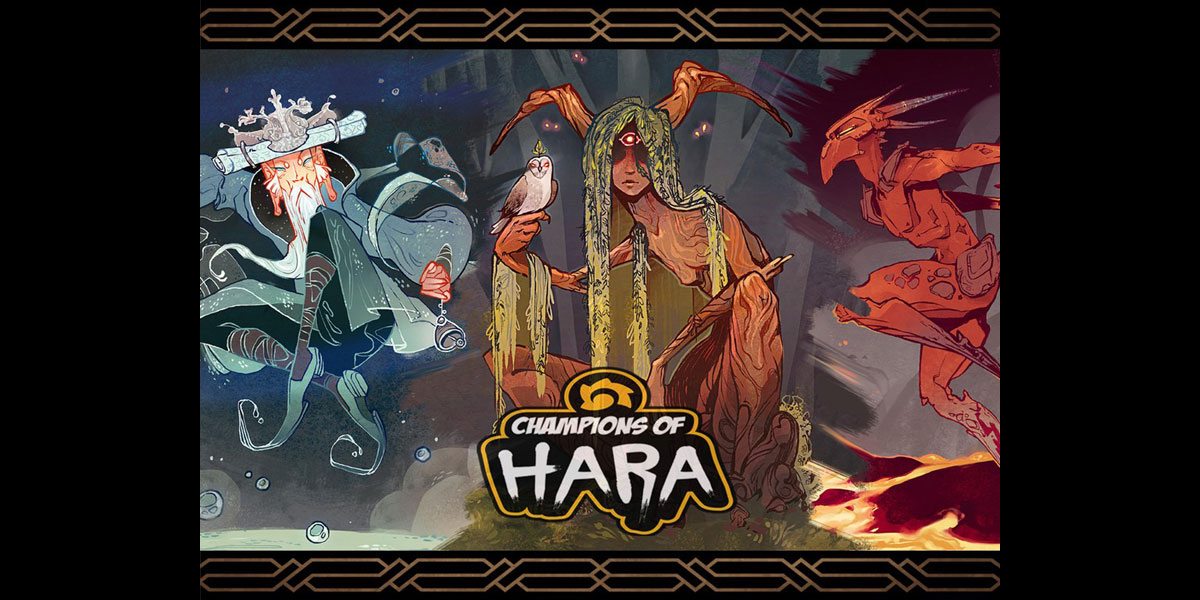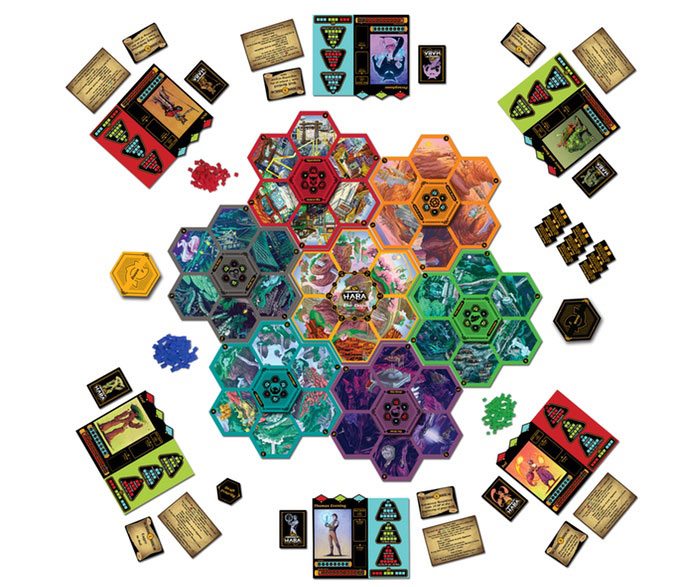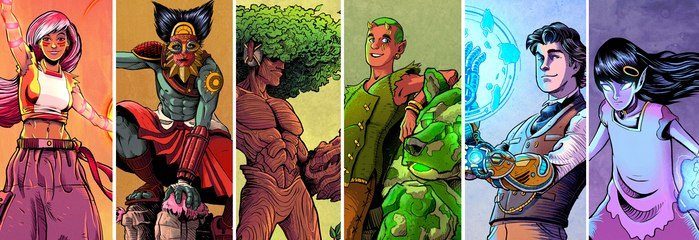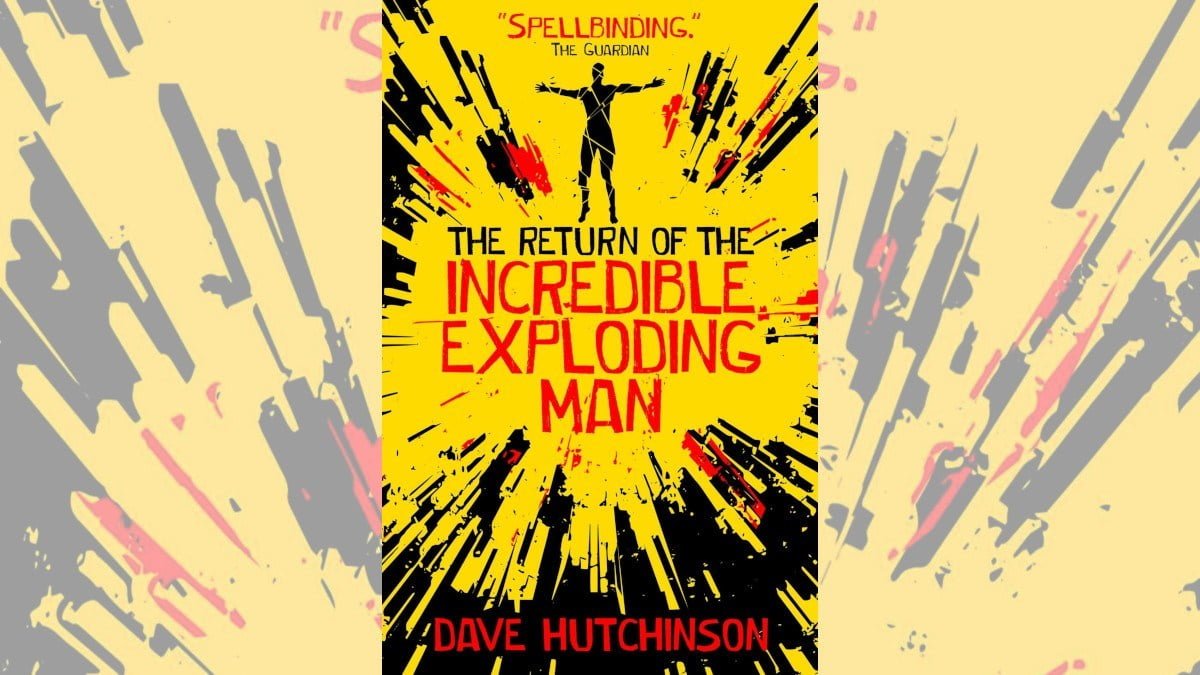The world of Hara is in danger: during the Conflux, the three primal energies that formed Hara run wild, threatening to tear it apart. You and others race to master the energies and seal the Conflux. You are the Champions of Hara.
At a glance: Champions of Hara is for 2 to 6 players, ages 12 and up, and takes about 30 minutes per player. It’s seeking funding on Kickstarter now, and there is a pledge level of $55 for a copy of the game. (The $70 level will also include some of the deluxe stretch goals if those are reached.)
New to Kickstarter? Read our crowdfunding primer.
Components:
- 7 world boards
- 8 hexagonal world decks
- 6 champion boards
- 6 champion power decks
- 6 cardboard champion pawns
- 1 first player token
- 150 energy cubes (50 each in red, green, blue)
- 2 world dice
- 6 priority tokens
- 10 Soul Wound tokens
- 6 player aid cards
- 1 round marker
I was sent a prototype to try out the game, so while the components are not final quality, I did get to see a lot of the artwork and how the game functions.

First, the world boards are big–though I’ve been informed that the final version may be about 10% smaller than the prototype. Each one is made of six hexes, and you put seven of them together to create the entire board. With that, plus each player’s champion board (and deck of cards and discard pile), you’ll need a good amount of space to play the game. Add to this the fact that you’ll need room for discard piles for 8 different hexagonal decks, the piles of energy cubes, and a couple of other bits. (We ended up keeping all the discards on a side table behind me.)
The artwork on the world boards and cards is nicely done. All of the artwork in the game has a comic book feel to it–and in fact there is a short comic that introduces the world and one of the champions, Thomas Evening. The only downside is that because the boards have artwork on every hex but the center (where the corresponding deck is placed), it can be a little overwhelming visually, and it can be hard to tell at a glance which spaces have cards on them and which are empty.

The champion boards have various information on them: a character portrait is prominently displayed on the left side, with trackers for actions and health below it. In the center are some spaces for storing energy cubes you acquire. On the right side of the board are many spaces for energy cubes–these are used for “attunements” that unlock additional abilities. Finally, on the top of the board above the portrait are three “energy alignment” spinners; each one can be turned to show red, green, or blue. The prototype version just uses brads for these but I imagine the final version will use plastic plugs or something.

There are two six-sided dice. One is just numbered, and the other shows six of the worlds corresponding to the hex boards. (The seventh world is the Dojo, and since nothing spawns there, it is not represented on the die.)

The player cards are regular rectangular cards, with a deck tied to each character–the backs of the card have artwork to help you easily distinguish them. The world cards are hexagonal, and are fairly large (at least in the prototype). The backs of the cards also show the types of energy that are present in that world–one is more common and is depicted larger, and one is less common.
Soul Wound tokens are taken if you run out of health. The priority tokens are drafted each round to determine turn order, and each one also has an associated ability; the later in the round you act, the better a bonus you will get.
How to Play
A draft of the rulebook is available here–it’s a Google Doc, so you can make suggestions for edits, too.
The goal of the game is to be first to achieve your “final attunement”–filling up the row of cubes at the bottom right of your player board.
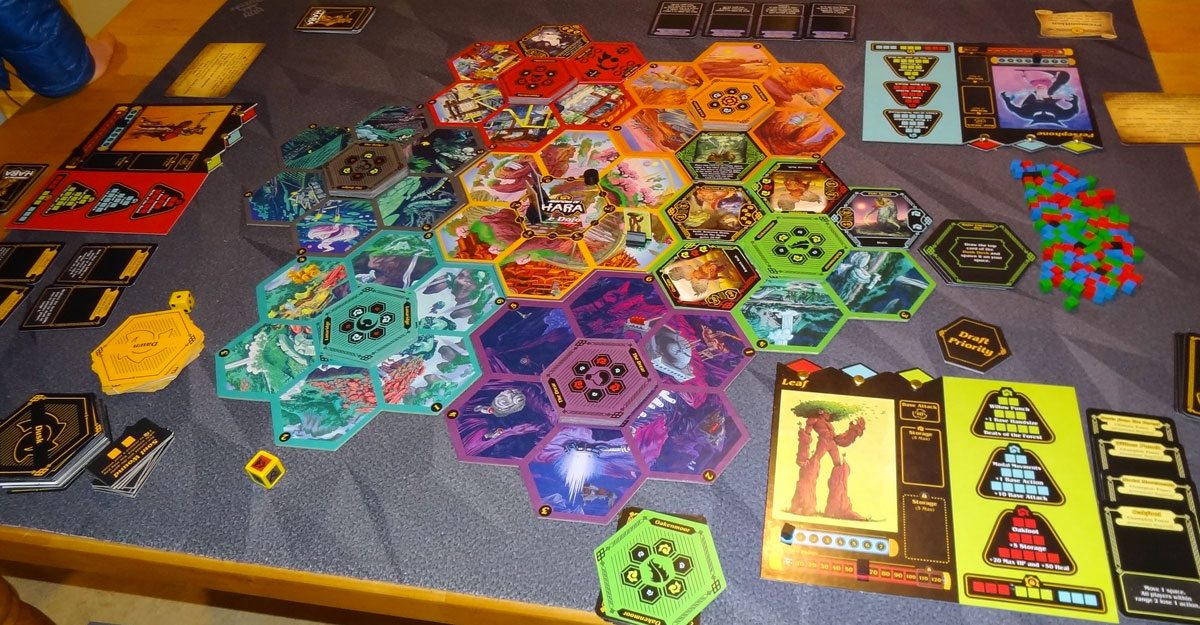
The board is set up with the Dojo tile in the center, and the six worlds placed next to it matching the colors on the edges. Each world’s deck is shuffled and placed on the center of the board; the Dawn and Dusk decks are shuffled separately and placed next to the board.
Each player should take a character board and the corresponding power deck. The four attunement cards are removed and set aside–these have to be earned before you get them–and the rest are shuffled. The player tokens all start on the center of the Dojo, and each player gets four cards. Everyone starts with 3 actions and 100 hit points (HP), marked on the character boards. The player chosen to be first player takes the first player marker.
Each “day” of the game takes two rounds, and consists of Dawn, Daytime, and Dusk.

First, at Dawn, you will spawn cards. The number of Dawn cards is fixed based on the number of players, but the number of Dusk cards is equal to the “day,” so it increases as the game progresses, maxing out at 6. For each card drawn, you roll the two dice to determine where it will spawn.
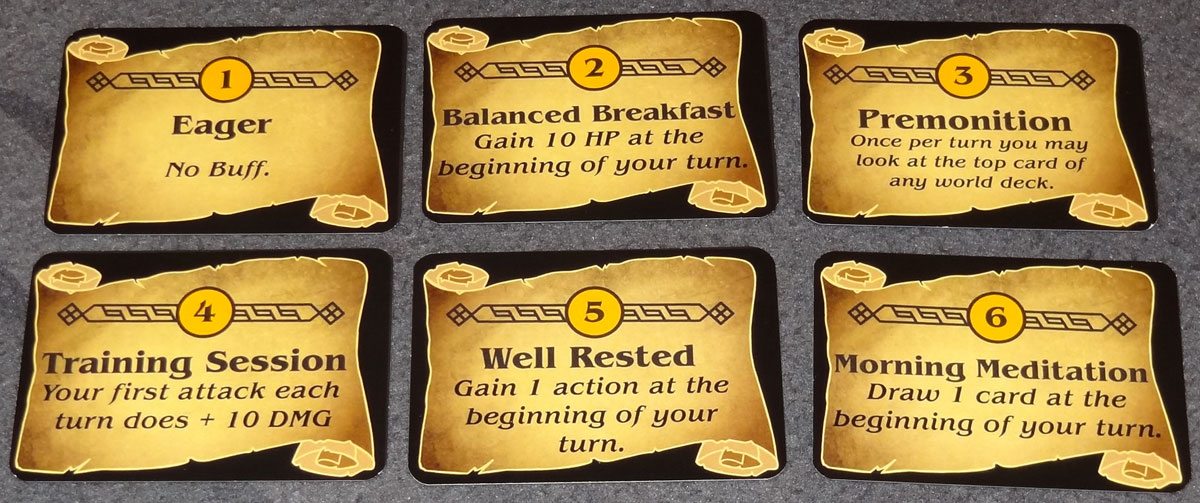
Then, in clockwise order starting with the first player, each player takes one of the priority tokens. These will determine your player order for that day (for two rounds of play), and all of the tokens except the first will give you some special ability as well.
Daytime is the phase of the game when players take actions. In turn order (according to priority), players then spend their actions and cards to move about the board and take actions. Moving a space costs an action, and having encounters (drawing cards from a world deck) also costs an action, though the first encounter each turn is free. You can also spend actions to turn the energy alignments on your player board.

Cards played from your hand are free and don’t count as actions–some of these will let you move faster, or spin an alignment dial, or add to your base attack. There are also cards that show three energy alignments at the bottom–if your energy alignment matches these (in any order), then the card gives the more powerful ability instead of its basic ability.

I won’t get into all the details here, but as you move about the board, you’ll encounter various creatures to fight, rifts to seal, items to pick up, and various other encounters. Most of these will have some sort of reward to get energy cubes, which you place into your storage. When you return to the Dojo, you may use your stored energy to achieve an attunement–you have to fill an entire row with the matching color, though you can fill rows in any order. Each attunement will give you new abilities–power cards, additional storage space, or even more actions.
At the end of your turn, you draw back up to your hand size (it starts at 4, but can be increased) and reset your actions (you start with 3 each turn, but you can increase this as well).
Once everyone has taken two turns, the Daytime phase ends.
At Dusk, everyone returns their priority cards to the pool, the first player token gets passed to the left, and then the world shifts. You roll the world die, and then that world swaps places with the Dojo (without changing orientation). Then another day begins.
If you ever run out of hit points (whether you were attacked by a monster or another player), you respawn in the Dojo with 70 HP and a Soul Wound–you’ll have to spend two energy cubes to heal the Soul Wound, and you can’t attempt your final attunement until you have no Soul Wounds left.
The game ends when somebody is able to achieve their final attunement, which requires getting three of each color energy cubes to the Dojo together. However, you can’t attempt that attunement until you’ve already filled all of your other attunements. That player is the savior of Hara and wins the game.

The Verdict
I first came across Champions of Hara at Gen Con last year, when I saw the three young men of Leaf Pile Media at a booth in the Entrepreneur Alley. I stopped to chat with them because I was impressed with the artwork they had on display, and although I didn’t get a chance to play the game, I was intrigued and left my card with them. At the time, they were expecting to launch a Kickstarter campaign in October, but the date got pushed back–presumably for more artwork and playtesting. Well, they’ve finally launched their campaign now.
My first impression still stands: Champions of Hara is visually impressive. The artwork is vivid and colorful, the board is huge, and I guarantee if you break this out at a convention people will be stopping to watch what you’re doing. And it’s pretty fun to play, too, though there were a few things I got wrong the first time through and I do have a few quibbles here and there.
Here’s what I liked: the turn-order drafting is a nice touch. It reminds me a little of the rooster mechanic in Viticulture, where getting up earlier lets you take your turn sooner–but sleeping in gives you some bonuses, too. I also liked the energy alignment mechanic with the three dials. I thought it was kind of gimmicky at first, but it actually made for some fun choices throughout the game. Do I spend some actions to get my dials into a particular configuration so I can use this card? Or do I just run over and close that rift because my alignments are currently set for that? Generally if your alignment is right, the cards are much more powerful, but sometimes you won’t have enough actions to spin all the dials and still get everywhere you want to be.
I’m always a fan of asymmetric powers. The basic powers among the characters are the same, but each one’s Champion powers are slightly different, which then affects the way you play. Persephone is able to get more actions by burning hit points. Leaf can knock other players around, and can also take away their actions. Thomas Evening has the ability to copy other players’ cards. It’s hard for me to know how well-balanced all these different abilities are after only a few plays, but I like when not every player behaves the same way.
The shifting of the world is pretty fun, too, though it may frustrate players who want to plan ahead several turns in advance. It happens once per day (every two rounds), and quite often the instinct is to run back to the Dojo before it happens–first, so you’re safe from attacks, but also so that wherever it moves, you can get back to it easily after your next turn. The downside of this mechanic is that at times it feels like you’re playing a dexterity game: picking up a hex supporting a deck of cards, several other loose cards, and maybe a few player tokens could be a recipe for disaster. We didn’t ever manage to spill a world board, but I could see that happening. (Note: I’ve been informed that the final boards will be of a thicker cardboard than the prototype, which should help–but you should still watch that you don’t bump your elbow or something while you’re carrying a full hex.)

I appreciate that there isn’t player elimination–you just respawn, and you lose some progress. But it does feel somewhat funny that you’re all champions trying to save Hara … and beating each other up because each of you wants to be the one champion who saves the world. Thematically it’s a little funny, but I suppose not unlike many other games. One of the stretch goals is a cooperative variant, and that sounds like it could also be a very fun way to play the game.
Champions of Hara is fairly long (the estimate of 30-40 minutes per player seems pretty accurate), and it’s one in which a single player’s turn can take a long time if they’ve managed to get extra actions, or particularly if there’s combat. When combat occurs, there’s a back-and-forth with the monster and player trading blows until one of them is defeated or the player flees. Most of the time we didn’t go attack a monster unless we could beat it in one or two hits (because it would only take a few hits for the monster to kill us), but if you fight several monsters in one turn, you can keep people waiting a while. This would, of course, be more pronounced the more players you have. But it really is the sort of game that I think simply takes that long to play, and I don’t think it’s one I would want to cut out gameplay for the sake of game length.
Overall, I think Champions of Hara looks like a very promising game if you and your friends like longer tactical games. It does get a little fiddly in places, but once you figure out what you’re doing it does flow nicely and there’s a good bit of competition, both direct and indirect. And the artwork is just outstanding.
For more information or to make a pledge, visit the Champions of Hara Kickstarter page.
Disclosure: I received a demo prototype of the game for this review.
